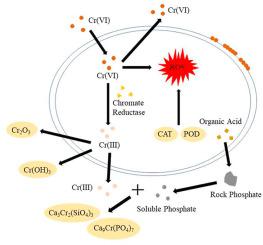Journal of Cleaner Production ( IF 11.1 ) Pub Date : 2021-09-18 , DOI: 10.1016/j.jclepro.2021.129062 Shuyu Guo 1, 2 , Chunqiao Xiao 1, 2, 3 , Yunting Zheng 1, 3 , Yizhong Li 1 , Ruan Chi 1, 3

|
Inappropriate mining strategies have led to the development of an increasing number of phosphate mining wastelands containing a large amount of rock phosphate (RP) contaminated with hexavalent chromium (Cr (Ⅵ)). Although bioremediation has been investigated as an effective strategy for Cr (Ⅵ) removal, few studies have focused on microbial remediation coupled with RP. In this study, a strain of Bacillus megatherium named PMW-03 isolated from a phosphate mining wasteland was used to remediate Cr (Ⅵ) contamination. The liquid medium experiment showed that strain PMW-03 exhibited significant insoluble phosphate solubilization and Cr (Ⅵ) resistance. The maximum release of soluble phosphate and removal rate of Cr (Ⅵ) reached 319.941 mg/L and 94.8%, respectively. The activities of antioxidation enzymes and chromate reductase reached 145.08, 153.71 and 40.07 U/min/gm, which indicated that the bioreduction process participated in the Cr (Ⅵ) removal of strain PMW-03. Furthermore, FTIR and XRD studies showed that Cr (Ⅵ) removal in RP coupled with PMW-03 was also attributed to the biosorption of functional groups on the surface of the strain and the formation of Cr-phosphate precipitates. Finally, the evolution of microbial community structures and functional gene abundance were analyzed to reveal the reduction of Cr (Ⅵ) by microbial remediation. These findings provide some reference and new insights for microbial remediation of Cr (Ⅵ) contamination in phosphate mining wastelands.
中文翻译:

分离的巨大芽孢杆菌PMW-03去除磷矿废弃地Cr(Ⅵ)污染及其潜在机制
不当的采矿策略导致了越来越多的磷酸盐采矿荒地的发展,其中含有大量被六价铬(Cr(Ⅵ))污染的磷酸盐岩(RP)。尽管生物修复已被研究为去除 Cr (Ⅵ) 的有效策略,但很少有研究关注与 RP 相结合的微生物修复。在这项研究中,一株巨大芽孢杆菌从磷酸盐采矿荒地中分离出的名为 PMW-03 的化合物用于修复 Cr (Ⅵ) 污染。液体培养基实验表明,菌株PMW-03表现出显着的不溶性磷酸盐增溶和Cr(Ⅵ)抗性。可溶性磷酸盐的最大释放量和Cr(Ⅵ)的去除率分别达到319.941 mg/L和94.8%。抗氧化酶和铬酸还原酶的活性分别达到145.08、153.71和40.07 U/min/gm,表明生物还原过程参与了菌株PMW-03的Cr(Ⅵ)去除。此外,FTIR 和 XRD 研究表明,RP 与 PMW-03 结合去除 RP 中的 Cr (Ⅵ) 也归因于菌株表面官能团的生物吸附和磷酸铬沉淀的形成。最后,分析微生物群落结构和功能基因丰度的演变以揭示微生物修复对Cr(Ⅵ)的减少。这些发现为磷矿废弃地Cr(Ⅵ)污染的微生物修复提供了一些参考和新见解。

























 京公网安备 11010802027423号
京公网安备 11010802027423号